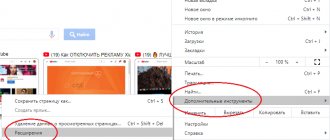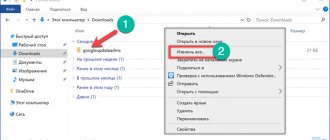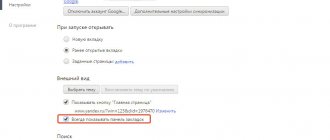Program description
Fortunately, your fears were not justified. Ghostery Storage Server is an application that blocks tracking and collection of metrics about online activities. Each website contains a number of modules (web viewers, counters, widgets, bugs, statistics collectors) that analyze information about web surfing, based on the data obtained, form a unique advertising platform and recommend Internet resources in accordance with the interests and localization of the user.
But this is only generally accepted information. No one knows where else this data might be going or for what purposes. Therefore, using such widgets will definitely not cause harm.
System requirements
- Firefox: 52+
- Firefox Android: 55+
- Chrome: 49+
- Opera: 36+
- Edge: 34.14291+
Ghostery for Chrome
Ghostery is a powerful privacy extension that blocks ads and disables tracking tools. Ghostery's built-in ad blocker removes advertisements from the page to eliminate site clutter. Allows you to view and block tracking tools on websites you visit, allowing you to control the collection of your data. The Smart Blocking feature speeds up page loading and optimizes page performance. Offers several toolbars to customize the display and processing of data.
Ghostery for Opera
Ghostery for Opera
Ghostery for Mozilla Firefox
Ghostery for Mozilla Firefox
Ghostery for Yandex Browser
Ghostery for Yandex Browser
Main functionality
The Ghostery Storage Server extension is designed for one main purpose: blocking surveillance. But this implies a number of additional functions that will make working on the Internet more enjoyable and safer.
- Increased site loading time. By blocking “invisible” components, the page volume is reduced, which leads to faster loading. In tandem with AdBlock, you will achieve maximum speed and security on your web resource. Only targeted content, nothing extra!
- Protection against misclicks. If you visit potentially dangerous sites, Ghostery blocks all suspicious transitions and notifies the user about it.
- User customization. After creating an account, you will see additional settings for working with the extension. Now you can add trusted sites and manually disable blocking of some bugs (they may be needed to fully work with the content on the page).
Advice! We recommend that you read another article: “Ads Killer Extension Review.”
Ghostery implements artificial intelligence to block ads
Photo: iStock
Ghostery has introduced artificial intelligence technology into its ad and tracker blocker. Wired talks about how the new browser extension works.
Most ad blockers work almost the same way: the programs compare scripts on sites with their “white list” and a list of what needs to be blocked and limit the operation of unwanted scripts. This means that most of these solutions have one drawback: blockers cannot block something they have not encountered before. AI can help solve this problem by adjusting tracker protection settings for each user. This will help inexperienced users.
Artificial intelligence is able to find out what information trackers collect about users. In doing so, the AI checks to see if the trackers are sending insecure data that allows their owners to identify a person and create a profile for a specific user. Once the AI decides that the tracker wants this data, the algorithms send random information to the tracker. This means that some advertising elements can be visible to the user without compromising his privacy, the publication notes.
Jeremy Tillman
Ghostery Product Manager
“There is a short list of trackers that we know about that are very important to the operation of the site. We can say that if you block some of them, the site will not display correctly."
Currently, Ghostery can block 2.6 thousand different trackers. Users can decide how many of them will block the extension, or disable or pause blocking for an individual page. This number of functions is attractive for experienced users. And for beginners, this may seem difficult, since by default it does not block anything, and blocking all trackers can prevent the user from watching videos or loading necessary elements of sites.
Therefore, the developers added Ghostery, which launches in one click after installing the browser extension. In “smart mode,” the extension will automatically make decisions for the user and adjust interactions with trackers in an attempt to increase user privacy and reduce page load times. In doing so, Ghostery will offer users a choice between new and traditional mode, allowing advanced users to choose the trackers they want to block.
Restricting the operation of site elements until it is confirmed that they contain advertising trackers can lead to problems with access to the resource. However, AI is able to cope with this task: if Ghostery determines that the user begins to constantly refresh the page, then the algorithm concludes that something is not working and changes the operating mode.
Ghostery's anti-tracker technology is already used by the privacy-focused browser Cliqz. The browser's makers bought the Ghostery extension and related apps in February. Ghostery's business model has changed: previously, the company sold anonymized data to the advertising industry and other companies interested in such data.
Many browsers have already begun to prohibit trackers from monitoring users' online activities. Thus, Firefox began blocking tracking in private browsing mode in 2020, and Apple began blocking trackers using machine learning in Safari this year. In 2020, Google will begin blocking some types of annoying ads in Chrome.
READ ALSO
Google will begin blocking ads in Chrome in 2020
Jeremy Tillman
Ghostery Product Manager
“There is an assumption that Google's ad blocker will work selectively. We don't have the same attitude about what we decide to block and what we don't. We have no personal gain."
Subscribe to our channel on Telegram!
How to delete?
If the add-on doesn’t interest you, or you simply don’t need it, you can get rid of it.
It's easy to do:
- Open your browser and go to “Extensions” (using Google Chrome as an example).
- Find Ghostery and click the Remove button.
- Confirm deletion.
After this, the bug blocker will leave the browser location.
How to use Ghostery?
1. Click on the Ghostery icon to display the extension menu. A welcome window will appear on the screen, in which you will need to click on the arrow icon to proceed further.
2. The program will begin a short training course that will allow you to understand how to use the program.
3. After completing the instructions, we will go to a site that is guaranteed to collect information about users - this is yandex.ru . Once you visit a site, Ghostery will be able to detect the tracking bugs hosted on it, resulting in the total number of them being displayed right on the extension's icon.
4. Click on the extension icon. The program's built-in tools for blocking various types of bugs are disabled by default. In order to activate them, you will need to move the toggle switches to the active position as shown in the screenshot below.
5. If you want the selected anti-bug to always work on an open site, to the right of the toggle switch, click on the check mark icon, coloring it green.
6. If for some reason you need to pause blocking bugs on the site, in the lower area of the Ghostery menu, click on the “Pause blocking” .
7. Finally, if your favorite site requires bug permission, whitelist it so Ghostery will allow it through.
Ghostery is an excellent free tool for the Google Chrome browser that will protect your personal space from spying by advertising and other companies.
Infection with a virus under the guise of Ghostery
There are known cases where viruses were hidden on the computer under the guise of ghstore.exe. If you notice frequent display of advertisements in browsers, slow PC operation and frequent freezes, check your machine for viruses.
To do this you need:
- Go to the Temp folder along the path C:\Windows\Temp and empty it.
- Install the following applications: AdwCleaner and CCleaner.
- After launching AdwCleaner, click the “Scan” button and wait for the procedure to complete. Then click “Cleanup”.
- Check the shortcut of the browser you are using and, if you find unnecessary information, delete it.
- Clean the registry using CCleaner.
Overall, the addition is useful and will add security to your daily life. Knowing what kind of program Ghostery Storage Server is, draw a conclusion about the advisability of using it in your situation. Safe internet surfing!
What is Ghostery?
It’s worth noting right away that this plugin is free and Russified. Ghostery was created to protect personal information from spying activities of various Internet sites. This add-on can easily find and neutralize scripts that collect information about you. Google analytics, social media buttons, Yandex.Direct advertising and other modules can be disabled using the Ghostery extension.
How to install the Ghostery plugin?
Installing Ghostery is no different from installing any other add-on. To get rid of tracking of your browser and successfully install the extension, you need to follow the following sequence of actions:
- Select browser settings (three horizontal lines in the upper right corner). We are interested in the “Add-ons” menu item, click on it;
- To install the extension, scroll to the end of the page with plugins;
- Click on the button “Catalog of extensions for Yandex browser”;
- Enter the name “Ghostery” into the search bar;
- Select the required plugin from the drop-down list and click “Install”.
You have successfully installed the extension to remove Yandex Browser tracking.
How to use Ghostery?
The add-on automatically starts working immediately after installation. To verify this, just go to any major website (for example, YYandex). The number of blocked modules will appear in the upper right corner of the plugin icon. Let's go see what the Ghostery nets caught? For this:
- Click on the plugin icon;
- Before you start using it, there will be a mini-course on working with the plugin (you can complete it or just close it). After completing or closing the courses, you will see a list of found scripts. By clicking on the corresponding slider opposite the module, you can disable it;
- If you want a particular script to be automatically blocked when you go to the site, check the box to the right of the switch;
- To stop the blocker, a “Pause blocking” button has been created;
- If you want Ghostery to not disable modules on this site, click on “White List”.
How to set up Ghostery?
To work more efficiently, any tool needs settings. Plugins are no exception to the rule. The settings menu is in the upper right corner, next to the login button. When pressed, a list of available operations pops up, including a gear icon. In the window that opens, you can configure:
- Global blocking (blocking selective trackers);
- Trust and restriction (list of sites without blocking and with automatic blocking of scripts);
- General settings (blocking, address display and other parameters);
- Setting up notifications;
- Take part (here you can regulate the sending of data to the Ghostery servers);
- Purple window (shows scripts on the page in real time);
- Account (import, export plugin settings).
How necessary is the Ghostery plugin for Yandex Browser?
Few people like to be under scrutiny and see advertisements for something they once requested on the Internet. Internet security has become increasingly important lately, so I think we need to take advantage of all the opportunities to ensure it. It's great that tools like Ghostery exist!











